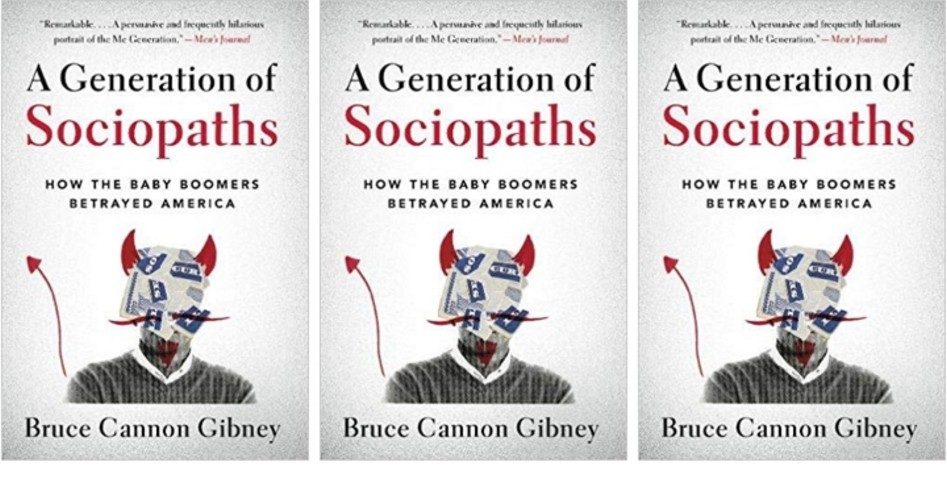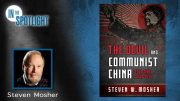
In the interest of full disclosure, this writer was born in 1952, roughly in the middle of the Baby Boomer generation.
It is not unusual to come across materials bashing Millennials and Generation Z as selfish, spoiled, hyper-sensitive, etc. But how often do you see the Baby Boomers bashed? When this writer happened to come across A Generation of Sociopaths: How the Baby Boomers Betrayed America by Bruce Cannon Gibney while browsing through a bookstore, he did a double-take, and then purchased the book to see what Gibney had to say.
The title of this book gives a pretty clear hint as to its thesis. However, lest there be any doubt, the author makes this statement in the book’s Introduction:
The central theme of this book is that America’s present dilemma resulted substantially and directly from choices made by the Baby Boomers. Their collective, pathological self-interest derailed a long train of progress, while exacerbating and ignoring existential threats like climate change. The Boomers’ sociopathic need for instant gratification pushed them to equally sociopathic policies, causing them to fritter away an enormous inheritance, and when that was exhausted, to mortgage the future. When the consequences became troubling, Boomer leadership engaged in concealment and deception in a desperate effort to hold the system together just long enough for their generational constituencies to pass from the scene. The story of the Boomers is, in other words, the story of a generation of sociopaths run amok.
So, who is Bruce Cannon Gibney, and what qualifies him to write this book? Obviously many readers (including this writer) would view as a red flag Gibney’s claim that climate change is an “existential threat” — but does this, by itself, mean that Gibney has nothing to offer?
If one looks up Gibney’s biographical details, one discovers that he is described as a “venture capitalist and writer.” His personal story provides a classic example of how luck can play a huge role in a person’s life. It turns out that Gibney’s roommate at Stanford University was a co-founder of PayPal, the electronic payments company, and offered Gibney a chance to be an early investor. After eBay bought out PayPal, Gibney worked for a hedge fund and made some private investments, one of which was acquired by Google. He then moved on to a venture capital firm, where he and his colleagues helped to fund start-ups that became such tech heavyweights as Facebook, Airbnb, and Lyft. Gibney says in the Foreword to his book, “Both jobs required me to think about where the markets would go, what companies might succeed, and by necessity, about the American future and the forces shaping it.” He was motivated to write the book, as he puts it, “to explore American stagnation.” It is worth noting that Gibney was born in 1976, which means that he is not a Boomer.
It is in the Foreword where Gibney also mentions that he defines the Baby Boom Generation “as the eroding middle-class white cohort born 1940 to 1964,” a starting point six years earlier than the traditionally accepted 1946. He acknowledges this in Chapter 1, “Convention dates the Boom to 1946, though it started as early as 1940, when the Depression finally lifted and Americans were enthusiastic about the future.” Conflating the start of the World War II economic boom with the later population boom cannot help but make some readers wonder whether there might be an ulterior motive involved. Sure enough, it turns out later in the book that this shuffling of dates allows Gibney to more easily make certain anti-Boomer points. For example, he cites a number of bad actors, through the course of the book, who were conveniently born between 1940 and 1945.
Near the beginning of the book’s Introduction, Gibney presents a graph labeled “Family Income — What Is and What Could Have Been,” which depicts the path that American family incomes have actually taken, versus what they “would have taken if they had kept growing at pre-Boomer rates.” The difference between what is and what could have been is significant and, according to Gibney, “is substantially the product of Boomer mismanagement and selfishness.” He adds, “Had America pursued more reasonable policies, it might have continued the pattern of growth of the golden years after World War II and before the arrival of Boomer power.” No acknowledgement is given, at this point, that those “golden years” might very well be the result of the fact that America bestrode the world as an unchallenged economic titan because the industrial bases of Europe and Asia were in ruins and would take decades to recover. Obviously, there was no way that such a situation was going to continue indefinitely. We are only three pages into the Introduction and the reader is already beginning to get the feeling that the book is starting with a premise and will subsequently be looking for data to back it up. That is not how an argument is supposed to be constructed.
However, Gibney does get around to addressing that “golden years” point in Chapter 15, “The Wages of Sin.” He claims that America did not have it easy after World War II because it had to deal with war debts and millions of returning soldiers. He also argues that post-World War II foreign aid, which was given to war-torn countries for the stated purposes of countering communism and expediting their economic recovery, made America less competitive than it could have been. Yet despite the post-war burdens on American taxpayers, he admits, “It was not in the 1950s, when Europe and Japan were in ruins, that America stalled, but much later, even as competitors wages, regulations, and currencies converged to American levels.”
Yes, much later, when the “golden years” were over, because pre-war economic competition had returned, backed up by brand new, state of the art industrial bases. But that easily understood truth appears to be of no interest to Gibney, presumably because it does not support his thesis. He concludes his argument by trying to lay a guilt trip on the Boomers: “Finally, there is something not merely untrue, but wholly depressing, even un-American, about the idea that the nation can only compete when the rest of the world is in ruins.” When it comes to exploring America’s stagnation, Gibney evidently has an axe to grind.
That axe is taken to the Boomers with a vengeance, whom Gibney refers to frequently as “antisocial” (in the sense of being harmful to organized society) and constantly as “sociopathic” (characterized by such psychopathic traits as ego-centrism, lack of empathy, and irresponsible risk taking). A more clinical description of sociopathy, taken from The Diagnostic and Statistical Manual of Mental Disorders, and how it relates to Boomer behavior, as Gibney sees it, is included in Appendix A, “Boomer Sociopathy — Ticking the Boxes.”
The first two chapters of the book, “The View from 1946” and “Bringing Up Boomer,” attempt to identify the “causes of Boomer sociopathy and the first expression of its symptoms, which began as personal and would end as political.” In a nutshell, Boomer sociopathy stems from 1) Dr. Benjamin Spock’s book on childcare, which promoted permissive parenting, 2) substituting bottle feeding for breast feeding, and 3) the arrival of television. Permissive parenting and television have been pervasive for multiple generations, but Gibney seems to be interested only in what he views as the unique sociopathy of the Boomers. Many readers might find it ironic that the Boomers were raised by what historians like to refer to as “the Greatest Generation” for their struggle through the Great Depression and victory in World War II. Yet the Greatest Generation also raised the Baby Boomers and therefore bear some responsibility for how the Boomers turned out. Which brings up the question: If the Boomers are as bad as Gibney claims, could the Greatest Generation be that great?
By this point, you are probably expecting me to tell you not to read this book. Actually, it is worth reading, especially for the intellectually curious (it’s one of the very few books that I’ve taken the time to read twice), because Gibney uses the remaining chapters to describe how he thinks that we got into the mess that we are in, and what to conceivably do about it. This book is a classic example of the divide-and-conquer strategy in action, turning one group against another, when we should be uniting to solve our common problems. If we want to neutralize the Gibneys of this world, we need to understand how they think, why they think that way, and the arguments they use to support their worldview. In his The Art of War, the famous Chinese general and military strategist, Sun Tzu, stated, “If you know the enemy and know yourself, you need not fear the result of a hundred battles.”
The book is well researched, if the endnotes are any indication. Where Gibney goes off the rails is in scapegoating the Boomers the way that the Nazis scapegoated the Jews in Germany: If any policy or phenomenon happens to benefit the Boomers, then that is proof of something sinister and the Boomers are behind it. We are supposed to believe that every time Boomer voters and politicians acted, it had nothing to do with human nature, and everything to do with a secretive, collective, evil intent. But Gibney tells those who want to bring up the Bilderbergers and the Trilateral Commission to “doff the tinfoil hats,” and he never mentions the Council on Foreign Relations. Gibney appears to be neurotically obsessed with the Boomers. Why? To paraphrase an old hair-dye commercial, “Only his analyst knows for sure.”
A Generation of Sociopaths: How the Baby Boomers Betrayed America, by Bruce Cannon Gibney, New York, New York: Hachette Book Group, Inc., 2017, 430 pages, paperback.



